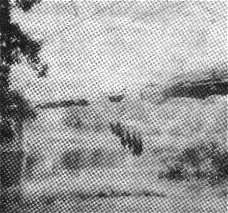
| |
Top Stories Headline News |
|
TRR Archive the Rue Morgue |
|
|
Editorials Editorials Columns Letters |
|
|
Arts & Leisure Reviews & Schedules |
|
|
Outdoors Fishing/Hunting Outdoor Magazine |
|
|
Sports Local Scores & Standings |
|
|
Food Recipes for culinary delights |
|
|
Bridges Bridges of the Upper Delaware |
|
|
Back Issues |
|
|
Search |
|
|
Links |
|
|
Commerce Sponsors |
|
|
Classified Ads Find it here |
|
|
Staff Pages |
|
|
Masthead |
|
|
Design Studio |
|
|
Subscriptions Get your copy delivered |
- SKINNERS FALLS -- Just two weeks into the work, repairs to the Milanville Bridge have not been going smoothly for Postupak Painting Co. of Wilkes-Barre, the subcontractor responsible for sandblasting and repainting.
- The crew tried fastening "outriggers" (tarps) to steel bars which were welded to the railings, but high winds bent the angle irons. The tarps were ineffectual and were being destroyed by the rebounding effect of the sandblasting, Marchesini said.
- Ted Waddell of the NPS Northern District office reported: "I observed [the] workers untie several retaining ropes, which dumped a concentrated accumulation of 'Black Beauty' sandblast material, rust, and paint debris unto the New York shoreline and the waters of the Delaware immediately below the bridge structure."
- "Black Beauty" sand is ground from slag, a waste product in the manufacture of steel. Marchesini claimed that the sand is purer than that which is found on the river bottom, but admitted that the red base coat of primer paint "could be" lead-based.
- DER objects to lead being dumped in the Delaware River because of its effect on fish and the environment.
- "You'd think these people would have had enough experience to know that when you're 30 or 40 feet high, there's not much more you can do," Marchesini said.
- He complained that the sandblasting work would have been done by now, but that state regulations intended to protect the ecology of the river were getting in the way.
- At present, the crew has done a small portion of sandblasting toward the New York side of the bridge, only a small portion over the water. "At the rate we're going, it'll probably be winter time before we reach the river," he asserted.
- Uninterrupted, the sandblasting operation would not take more than a total of two weeks, he said.
- Marchesini told The River Reporter that he was "at least as concerned" about the river as the state officials who are monitoring the project. "It's so beautiful here!" he said, "I don't want to destroy it. All I want to do is paint this bridge."
- He added that if any agency or individual had suggestions about how he could keep the debris from falling in the water, the crew would try them.
- NPS chief ranger Glenn Voss admitted that the park service experienced similar difficulties in sandblasting the historic Roebling Bridge at Lackawaxen, and had also been unable to prevent some debris from falling in the water.
- "The last time we did a bridge over this river [at Pond Eddy] was seven years ago, and there weren't so many restrictions," said Marchesini.
- "Before we go over a river like this again it's going to cost them $100,000 just because the name of the river is the Delaware. Believe me!" he exclaimed.
- Marchesini said that the contractor can not start structural repairs until the sandblasting is done.
- In a separate incident the morning of June 6, an empty, tanker truck pulling a trailer full of sand, both owned by Postupak overturned on the road between the old Lenape Tavern building and the railroad tracks.
- The accident was apparently caused by the soft ground collapsing under the weight of the heavy load.
- NPS rangers Robert Weber and Alan Henry radioed for assistance. The vehicles were righted by Palmer's Towing Service of Indian Orchard.
- Concerning the two mishaps, NPS Superintendent John Hutzky remarked, "Everybody has accidents."
- Hutzky indicated that he still has not received a River Safety plan from the contractor or from PennDOT, despite repeated requests.
- Marchesini said that his crew does not work on weekends because of the high numbers of canoeists, rafters, and tubers passing under the bridge. Skinners Falls is the most popular recreation spot on the Upper Delaware.
- He said that when pedestrians attempt to cross the bridge on foot, his workers stop their blasting until the person is out of the way.
Related external links
- The crew tried fastening "outriggers" (tarps) to steel bars which were welded to the railings, but high winds bent the angle irons. The tarps were ineffectual and were being destroyed by the rebounding effect of the sandblasting, Marchesini said.
-
- Upper Delaware Scenic & Recreational River
- Pennsylvania Department of Environmental Protection
- NYS Department of Environmental Conservation
- Upper Delaware Scenic & Recreational River
Thursday, June 19, 1986.
Problems plague workers at
See related articles here
Milanville Bridge
By TOM RUE

Tarps were fastened to the bridge to catch falling debris, but were then accidently dumped into the river after they had filled. Pictured is the debris as it fell in the river on June 11.